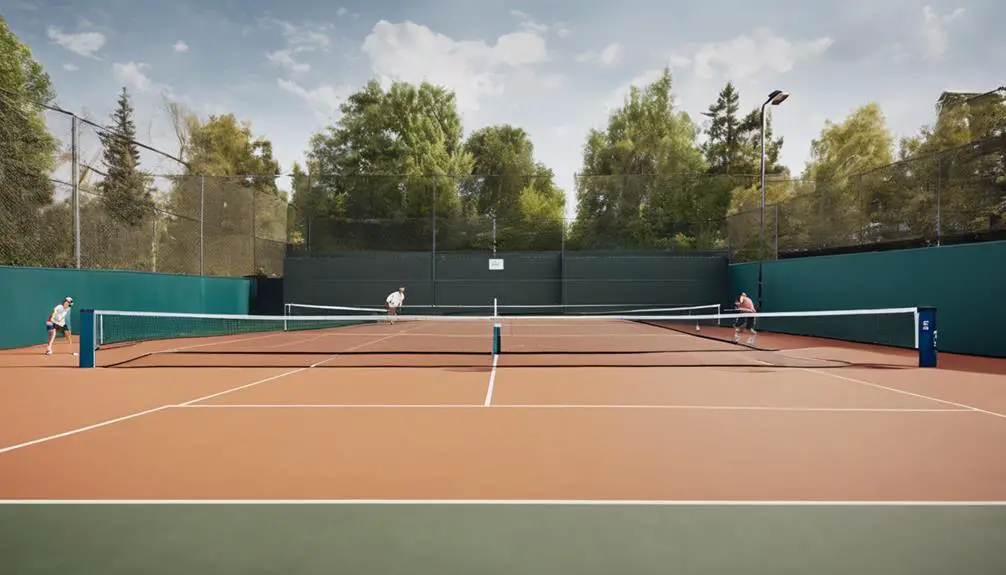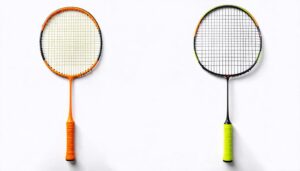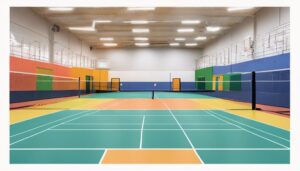When comparing pickleball and tennis rules, you’ll notice some key differences. The court sizes vary, with pickleball being smaller at 20 feet wide and 44 feet long. Equipment also differs; players use solid paddles for pickleball and stringed rackets for tennis. Scoring systems are distinct as well, with pickleball using rally scoring to 11 points and tennis using a 15-30-40 format. Serve rules require underhand serves in pickleball, while tennis allows overhand. Understanding these differences can enhance your play. There’s so much more to explore about strategies and gameplay in each sport.
Court Dimensions Comparison

When you look at the court dimensions, you’ll notice some key differences between pickleball and tennis that can impact your gameplay. Pickleball courts are considerably smaller, measuring 20 feet wide and 44 feet long, compared to tennis courts, which are 36 feet wide and 78 feet long for doubles play. This size difference means that you’ll often find yourself closer to the net in pickleball, leading to faster exchanges and a different style of play.
Another point to reflect upon is the net height differences. The pickleball net stands at 36 inches at the ends and 34 inches in the middle, while the tennis net is 42 inches at the posts and 36 inches at the center. This lower net in pickleball can lend itself to more strategic shots, allowing for greater finesse and angles.
You’ll also want to think about court surface materials. While many tennis courts are made of hard courts, clay, or grass, pickleball courts are often found on similar surfaces but can also be made from specific materials designed for the game, like a textured plastic or composite, which can affect ball bounce and player movement. These surface variations can influence how you approach each sport, as well as your overall experience.
Understanding these court dimensions, net height differences, and surface materials will help you adapt your game and enjoy the unique aspects of both pickleball and tennis.
Equipment Differences
The equipment used in pickleball and tennis showcases some notable differences that can profoundly affect your gameplay. Understanding these distinctions can help you choose the right gear for your preferred sport, enhancing your overall experience on the court.
- Paddle Types: In pickleball, you use a solid paddle, typically made from wood or composite materials. The paddle’s size and weight can vary, allowing you to find one that suits your playing style. In contrast, tennis employs rackets that have a stringed face, which can dramatically influence ball control and power.
- Ball Materials: The balls differ considerably as well. Pickleball uses a lightweight plastic ball with holes, designed for reduced bounce and slower speeds. Tennis balls are made of rubber and covered in felt, allowing for high-speed play and a greater bounce.
- Court Accessories: While both sports require nets, the net height and dimensions differ. A pickleball net is slightly lower than a tennis net, accommodating the unique dynamics of pickleball play.
- Footwear: The type of shoes you wear can also vary. Pickleball players often prefer shoes that provide lateral support and grip for quick movements. Tennis shoes are designed for durability on hard courts, with a focus on forward and backward motion.
Scoring Systems Explained

Understanding the scoring systems in pickleball and tennis is vital for players at any level. Both sports utilize distinct methods for keeping track of points, which can influence your strategy and overall gameplay.
In tennis, the traditional scoring system is used. Points are counted as 15, 30, 40, and game, with players needing to win six games to take a set. If both players reach 40, it’s called deuce, and one player must win two consecutive points to secure the game. This system emphasizes individual rallies, making each point essential in determining the game’s outcome.
In contrast, pickleball often employs a rally scoring system, meaning that every serve can result in a point for either team, regardless of who served. This can speed up the game considerably and create a more dynamic match atmosphere. Players typically play to 11 points, winning by at least two points. The use of rally scoring can encourage more aggressive play, as every rally counts.
Both systems have their merits. Traditional scoring in tennis can create tension during tight games, while rally scoring in pickleball guarantees that matches are fast-paced and engaging. Understanding these differences will not only enhance your gameplay but also deepen your appreciation for each sport. So, whether you’re rallying on the court or strategizing your next point, knowing the scoring systems will empower you to play with confidence.
Serve Rules
In both pickleball and tennis, serve rules play a significant role in how the game unfolds. Understanding these rules can enhance your performance and strategy on the court. While both sports have their unique serving regulations, they also share some fundamental principles. Here’s a breakdown of the key differences and similarities:
- Serving Motion: In tennis, you can use an overhand serve, while in pickleball, you have to serve underhand. This difference influences your serve techniques and can impact your strategy.
- Serve Placement: In tennis, you aim to place your serve anywhere in the service box, whereas in pickleball, the serve must land in the diagonal court. This requires you to adapt your serve strategies based on the sport.
- Serving Order: In tennis, players alternate serves every game, while in pickleball, the serving player continues until they lose a point. This means you need to be prepared for longer service stretches in pickleball.
- Faults and Lets: Both sports have specific faults, but in tennis, you can serve again if the ball hits the net but still lands in the service box (a let). In pickleball, however, a let serve results in a replay, which can shift your mindset during a vital point.
Volleying Regulations

When it comes to volleying regulations, both pickleball and tennis have distinct rules that shape how players engage at the net. Understanding these rules is vital for developing effective volleying techniques and strategies in either sport.
In pickleball, you must keep your feet behind the non-volley zone line when volleying, which creates a unique dynamic at the net. This restriction encourages players to use precise positioning and timing to execute their shots effectively. In contrast, tennis allows players to volley anywhere on the court, offering more freedom but requiring a different set of skills to control the ball under pressure.
Here’s a quick comparison of volleying regulations in both sports:
| Aspect | Pickleball | Tennis |
|---|---|---|
| Non-Volley Zone | Must stay behind the line | No restrictions on position |
| Contact Position | Can only volley from the air | Can volley on the ground or air |
| Foot Placement | Feet must not cross the line | No specific foot regulations |
| Game Strategy | Focus on placement and patience | Emphasize power and precision |
In both games, mastering volleying strategies is imperative for maintaining an advantage during rallies. Whether you’re anticipating your opponent’s next move or aiming for the open court, being aware of the regulations will help you refine your approach and enhance your overall performance on the court.
Faults and Infractions
Throughout a match, players in both pickleball and tennis must be vigilant about faults and infractions, as these can greatly impact the game’s outcome. Understanding the various fault types and how rule enforcement works in each sport is vital to your success on the court.
In pickleball, faults can occur in several ways, such as:
- Serving Errors: If the serve doesn’t clear the net or lands outside the correct service area, it’s a fault.
- Double Bounce Rule: Failing to let the ball bounce once on each side after the serve results in a fault.
- Net Violations: Touching the net or crossing the centerline during play is a fault.
- In the Kitchen: Stepping into the non-volley zone (the kitchen) during a volley counts as a fault.
On the other hand, tennis has its own set of fault types, primarily focused on serving and court positioning. For instance, a double fault—a failure to successfully serve twice—results in a loss of the point. Additionally, hitting the ball out of bounds or into the net when returning a serve also constitutes a fault.
Rule enforcement in both games requires players to be honest and fair. In pickleball, players often self-officiate, so understanding the rules is essential. In tennis, umpires or referees may call faults, adding another layer of authority. By being aware of these faults and infractions, you can play more strategically and maintain the integrity of the game.
Game Format Variations

Game formats in pickleball and tennis exhibit distinct variations that cater to different player preferences and competitive levels. In pickleball, you can choose between singles and doubles, with doubles being the most popular format. This allows for engaging doubles strategies that emphasize teamwork and communication. In contrast, tennis also offers singles and doubles, but matches can be played in various formats like best-of-three or best-of-five sets, adding an extra layer of complexity to the game.
Here’s a quick comparison of game formats:
| Game Type | Pickleball Format | Tennis Format |
|---|---|---|
| Singles | Play to 11 or 15 points | Best-of-three or best-of-five sets |
| Doubles | Play to 11 or 15 points | Best-of-three or best-of-five sets |
| Mixed Doubles | Commonly played, same rules | Widely played, same rules |
No matter the game you choose, player etiquette remains vital in both sports. Being respectful, calling out faults, and recognizing good plays are essential components of a positive playing environment. Understanding and adapting to the different game formats can enhance your experience, whether you’re enjoying a casual match or engaging in competitive play. Embrace the freedom of trying out various game formats, and you’ll discover what resonates best with your style and preferences.
Player Positions
Positioning players effectively is essential for success in both pickleball and tennis, as it directly influences strategy and teamwork. Understanding the nuances of player formations can give you and your partner a significant edge, especially in doubles play. Here are some key doubles strategies to contemplate when positioning yourselves on the court:
- The Side-by-Side Formation: This formation allows you to cover the court width effectively. It’s great for defending against strong shots, but be cautious of leaving the center open.
- The Up-and-Back Formation: In this setup, one player is positioned at the net while the other stays at the baseline. This can create pressure on your opponents, especially when the net player poaches for shots.
- The Diamond Formation: This is a more advanced strategy where one player covers the forehand side while the other stays in the back. It helps in controlling the angles and can confuse your opponents.
- The Swarm Formation: Here, both players advance to the net together. It’s an aggressive tactic designed to dominate the point and pressure your opponents, but it requires excellent communication.
Unique Gameplay Aspects

Understanding player positioning sets the stage for appreciating the unique gameplay aspects of pickleball and tennis. In both sports, the dynamics revolve around how you utilize the court, but the strategies diverge markedly. In tennis, the larger court size demands a higher level of player endurance. You’ll find yourself covering more ground, which can lead to longer rallies and more tactical gameplay. Your game strategy involves not just placement of shots but also anticipating your opponent’s movements across the expansive area.
On the other hand, pickleball’s smaller court size allows for quicker exchanges, emphasizing precision over power. Here, the pace is fast, and reactions become vital. You’ll notice that the “kitchen” area adds an extra layer of strategy; you need to decide when to approach the net or stay back, which can shift the momentum of the game instantly.
Each sport influences your game strategy in different ways. In tennis, you may focus on building points and wearing down your opponent, while in pickleball, quick reflexes and smart shot selection become essential.
Ultimately, while both sports share a core foundation, the unique gameplay aspects make them distinct. Whether you’re engaging in a long, strategic rally in tennis or executing a quick volley in pickleball, understanding these differences can enhance your game experience. Embrace the freedom of playing either sport, and enjoy discovering the unique strategies that each offers!
Frequently Asked Questions
Can Pickleball Be Played Indoors and Outdoors?
Yes, you can play pickleball in both indoor facilities and outdoor courts. Each setting offers unique experiences, allowing you to enjoy the game regardless of weather conditions or personal preferences for a more versatile play environment.
What Age Groups Are Most Suitable for Pickleball?
When considering age demographics for pickleball, it’s suitable for all ages, especially beginners. Young children can learn basics, while older adults enjoy its low-impact nature, making it a fantastic choice for everyone seeking fun and exercise.
Is There a Difference in Player Stamina Requirements?
When considering stamina comparison, it’s clear that endurance training varies between sports. You’ll find that one sport may demand more sustained energy, while the other focuses on quick bursts, impacting your overall stamina needs.
How Do the Social Aspects of Pickleball Compare to Tennis?
When considering social aspects, you’ll find pickleball fosters strong community engagement and player camaraderie, often encouraging friendly interactions. In contrast, tennis can feel more competitive, which might limit those social connections you seek.
Are There Professional Tours for Pickleball Like in Tennis?
Yes, there’re professional leagues for pickleball, with over 1,000 tournaments annually. These leagues feature various tournament formats, offering players opportunities to compete and showcase their skills, similar to what you see in tennis.




